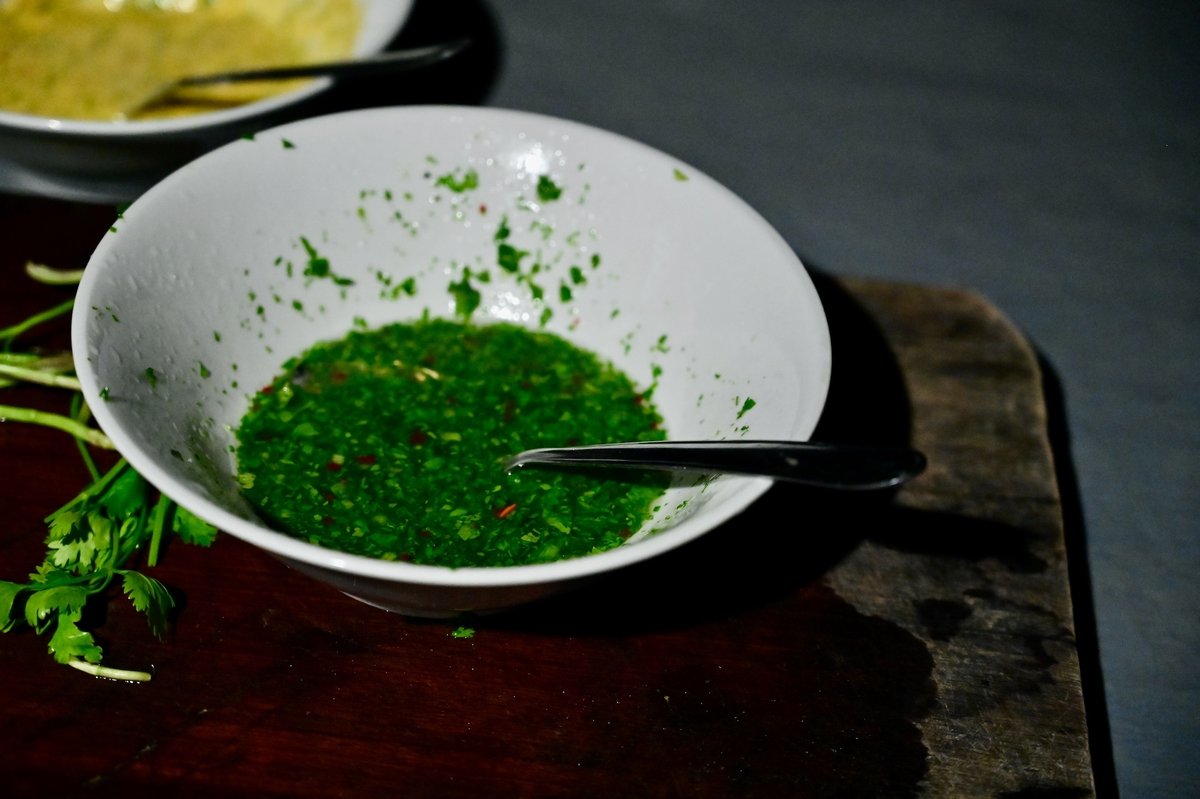
ペルー編7:アマゾンの宿で料理教室
English Follows Japanese
今夜の食事は巨大ナマズとワニ
2023年2月16日夕方、僕たちザ・ハーブズメン一行は「アマゾンの台所」ベレン市場の喧騒に疲れ、再びアマゾン川支流のモモン川に浮かぶ宿「アマゾン・オアシス・ロッジ」に戻ってきた。
目の前の川に飛び込んで、向こう岸まで二往復した後に部屋のハンモックで昼寝をしていると、ゆっくりと日が暮れてきた。今夜もジャングルの浮き宿でアマゾンの濃密な生き物の気配に囲まれて眠るのが待ち遠しい。だが、その前に少し腹が減ってきた。
宿の中央棟のテラス席に行くと、既にシャンカール・ノグチさんと水野仁輔さんが宿の女性従業員と話し込んでいた。

「今日は買い物に行ったのでパイチェ(ピラルク)のほかにもドンセラ(タイガーショベルノーズキャットフィッシュ、要は巨大ナマズ)とラガルト(ワニ)があります。タカチョ(甘くないバナナの団子)も美味しいですよ」
おお、ついに前日に養殖場で見たワニを食べる機会が来た! しかもワニのセビーチェなんて一体どんな味なんだろう? 更にドンセラも昼間のベレン市場で毒々しい白黒の市松模様の皮が付いた切り身を見たばかりだった。


「それではラガルトのセビーチェとドンセヤのチチャロン(フライ)、そしてタカチョをお願いします。それから、キッチンで作っている所を見せてもらえませんか?」
「もちろんウェルカムです!」
宿のキッチンで料理教室
ラッキー! なんでも言ってみるものだ! 中央棟の2階にあるキッチンに行くと、セサールによく似た顔つきの若いシェフが食材を用意していた。セサールの弟だろうか? そこに先ほどの女性従業員も加わり、二人がかりで調理が始まった。

「最初はタカチョです。タカチョには皮が黄緑色の未熟なバナナを使います。実は火を通すと真っ黄色になるんです」
女性従業員はそう言って、冷蔵庫から真っ黄色のバナナの炒め物を取り出し、それを底の厚い鍋に入れ、すりこぎを使ってすりつぶし始めた。そしてマッシュポテト状になったバナナを掌で握って直径5cmほどのボール状に固めた。まるでおにぎりのような、団子のような。あっと言う間にバナナの団子、タカチョが完成した。

男性シェフのほうは最初にたっぷりの香菜とセロリに似た野菜の葉、ほんの少しのにんにくを刻んで丼に入れ、そこに塩とたっぷりのレモン汁を足してセビーチェ用の緑色のマリネ液を作った。それから冷蔵庫から鶏の胸肉に似た白身の肉を取り出した。これがラガルト、ワニの肉だそうだ。それを2cmのサイコロ状に刻んで丼に入れ、上から熱湯を注ぎ入れた。

「ワニは生ではなく、軽く熱を通したほうが美味しいんです」

ふ~、助かった! 川魚に続いてワニまで生で食べて我々は肝炎などにならないだろうか?と少々不安になっていたところだったのだ。
ワニの肉は一分ほど熱湯に漬けた後、水気をしっかり切ってから先程の緑色のマリネ液に漬ける。その際に紫タマネギのスライスと、アヒ・チャラピタという直径1cmほどの丸くて黄色い生の唐辛子も一緒に漬け込み、セビーチェ・デ・ラガルトがほぼ完成だ。

続いてシェフが冷蔵庫から淡白そうな白身魚のフィレを取り出し、2cm幅の短冊状に切り分けた。さすがに市松模様の皮は剥がされていたが、ドンセラ(タイガーショベルノーズキャットフィッシュ)だそう。切り分けた身に塩コショウをして、小麦粉とトウモロコシ粉と卵を溶いた衣を絡めて、たっぷりの油でキツネ色になるまで揚げて、チチャロンも完成。ここまでトータル25分でアマゾンの料理教室が終了した。それでは1階に戻っていただきまーす!


見た目じゃない! 繊細で淡白なアマゾン料理の数々
まずはバナナの団子のタカチョから。付け合せはオリーブオイルで炒めてから炊いたピラフ、そして昼間にベレン市場で見かけたオレンジ色したアマゾン・ベーコンこと、セシーナ。更に白い削り節状のものは椰子の芽のスライス、チョンタ。
タカチョをフォークの先で崩して、口に入れると食感はねっとりしていて、バナナの団子と言うよりも豆やジャガイモの団子のよう。また玉ねぎとセシーナと一緒に炒めてあるので、肉の出汁が効いている。筍の穂先に似たチョンタと一緒に食べると美味い。


次にワニのセビーチェ、付け合せは茹でたユカ=キャッサバと炒ったピーナッツ。半生程度に湯通したワニ肉は鶏肉そっくりの味と食感。たっぷりの香菜とアヒ・チャラピタの爽やかな辛さが効いていて悪くない。

3つ目は巨大ナマズ、ドンセラのフライ、チチャロン。付け合わせはタカチョと同じくセシーナとチョンタだ。アツアツのうちにレモンをしぼって口に入れると、凶悪な見た目からは想像出来ないほど上品なホロホロの白身だ。ほぼハモの天ぷらじゃないか! 美味い! 美味すぎる!

アマゾンの食材を使った料理は、食材の毒々しい見た目からは全く想像が付かないほど繊細だったり、淡白だったり、普通に美味いのだ。
やっぱり何事も外見だけで判断してはいけない、中身こそ重要なのだなあ…今日は重要なことを学んだなあ…。4人で静かに内省していると、女性従業員が大きなお皿を運んできた。お皿には真っ黒に焦げた巨大な肉塊がドーンと乗り、指先には鋭い鉤爪、前腕部にはたくましいほどの筋肉が~!

「アマゾンの料理を楽しんでいただけて何よりです。これは宿からのおごり、ワニの前腕のBBQです。美味しいですよ。遠慮せずに召し上がって下さいね!」
やっぱり見た目も重要だと思うよ~、料理には~!


Cooking Class at the Amazon Lodge
Tonight's Dinner: Giant Catfish and Crocodile
On the evening of February 16, 2023, we, The Herbsmen, returned to the "Amazon Oasis Lodge," floating on the Momon River, a tributary of the Amazon, weary from the hustle and bustle of Belén Market, known as the "Kitchen of the Amazon." After diving into the river in front of the lodge for a couple of rounds, I took a nap in the hammock in my room as the day slowly turned to dusk. I was looking forward to sleeping surrounded by the dense presence of Amazonian wildlife in our floating jungle lodge. But before that, I started feeling a bit hungry.
As I made my way to the terrace seating of the central building, I found Shankar Noguchi and Jinpei Mizuno already engaged in conversation with a female employee of the lodge.
"Since we went shopping today, we have Pirarucu, as well as Doncella (Tiger Shovelnose Catfish, essentially a giant catfish), and Lagarto (crocodile). Tacacho (unsweetened banana dumplings) is also delicious."
Ah, the opportunity to finally eat the crocodile we saw at the farm the day before has arrived! And what does crocodile ceviche even taste like? Moreover, I had just seen the striking black and white checkered patterned fillets of Doncella at the Belén Market in the afternoon.
"Then, please give us Lagarto ceviche, Doncella chicharrón (fried), and Tacacho. Also, could you let us see how it's made in the kitchen?"
"Of course, you're welcome!"
Cooking Class in the Lodge's Kitchen
Lucky me! It pays to ask! Heading to the kitchen located on the second floor of the central building, a young chef with a resemblance to Cesar was preparing the ingredients. Was he Cesar's brother? Joined by the female employee from earlier, they began cooking together.
"First, we'll make Tacacho. For Tacacho, we use unripe bananas with greenish-yellow skin. Actually, when cooked, they turn bright yellow."
Saying so, the female employee fetched some bright yellow fried bananas from the fridge, placed them in a thick-bottomed pot, and started mashing them with a pestle. Then, she shaped the mashed banana into balls about 5cm in diameter with her hands, like rice balls or dumplings. And just like that, banana dumplings, or Tacacho, were ready in no time.
The male chef began by chopping plenty of cilantro and a vegetable similar to celery, with just a bit of garlic, into a bowl. He then added salt and plenty of lemon juice to create a green marinade for the ceviche. Next, he took out a piece of meat resembling chicken breast from the fridge. This was Lagarto, crocodile meat. He diced it into 2cm cubes and added them to the bowl, pouring hot water over them.
"Crocodile tastes better when it's slightly cooked, not raw."
Phew, saved! We were a bit worried about eating raw river fish and now crocodile—were we going to get hepatitis or something?
After soaking the crocodile meat in hot water for about a minute, it was drained well and then marinated in the green marinade prepared earlier, along with slices of purple onion and Aji Charapita, a small, round, yellow chili pepper, making the Ceviche de Lagarto almost ready.
Next, the chef took out a white fish fillet from the fridge, looking bland. Though its checkerboard skin was removed, it was indeed Doncella (Tiger Shovelnose Catfish). He cut the fillet into 2cm wide strips, seasoned them with salt and pepper, coated them in a mix of flour, cornflour, and beaten eggs, and fried them in plenty of oil until golden brown to complete the Chicharrón. In total, our Amazonian cooking class wrapped up in about 25 minutes. Now, let's head back downstairs to enjoy!
Delicate and Light Dishes of the Amazon
First up was Tacacho, the banana dumplings. They were served with pilaf fried in olive oil and the Amazonian bacon, or Cecina, we saw at the Belén Market in the afternoon, along with white, flaked slices of palm shoots, Chonta. Crumbling Tacacho with a fork and tasting it, the texture was sticky, more like a dumpling made of beans or potatoes than banana. Also, since it was fried with onions and Cecina, the meat's broth flavored it well. Eating it with Chonta was delicious.
Next was the crocodile ceviche, served with boiled yuca (cassava) and fried peanuts. The partially boiled crocodile meat had a taste and texture just like chicken. The abundant cilantro and the refreshing spiciness of Aji Charapita worked well, not bad at all.
The third was Chicharrón of the giant catfish, Doncella, served again with Cecina and Chonta. Squeezing lemon over it while hot and tasting, the menacing appearance belied its refined, flaky white flesh. It's almost like hamo (pike eel) tempura! Delicious! Too delicious!
The dishes made with Amazonian ingredients turned out to be delicate, light, and genuinely delicious, far from the venomous appearance of the ingredients.
Just as we were quietly introspective, the female employee brought in a large plate. On it was a giant chunk of meat, burnt black, with sharp talons at the fingertips and muscular forearms—!
"I'm glad you enjoyed the Amazonian cuisine. This is on the house from the lodge, BBQ crocodile forearm. It's delicious. Please, don't hesitate to enjoy!"
I still think appearances matter, at least in cooking—!
この記事が気に入ったらサポートをしてみませんか?
